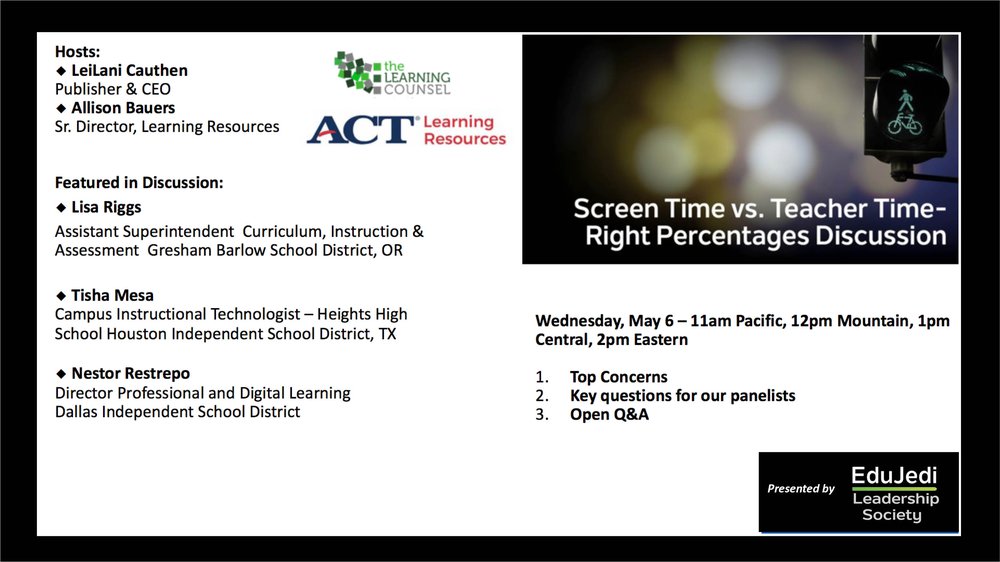Studies identify the optimum screen time for children, and most schools are very careful to adhere to the guidelines. Even so, the question of screen time is never far in the background, especially during this time of COVID-19 and forced virtual learning. In this episode of the Learning Counsel’s Crossroads virtual discussions, you’ll hear some of America’s leading experts in virtual learning address the problem.
As virtual learning becomes the new norm for schools, the question of screen time has once again been placed front and center. According to LeiLani Cauthen, CEO and Publisher at the Learning Counsel, “Right now, this is what we're hearing from a research perspective and on-the-ground discussions with so many educators since the quarantine started. This one has been in the news for years; Some people think the kids aren't living in life, they're not getting out like before the age of mobile phones and iPads, that kids are just glued to these devices and their world has collapsed into this digital network mode or that students are isolated. They worry that kids are isolated on screen and they're getting no real group dynamic.
“Those people typically don't have any real acquaintance with high value digital courseware or digital curriculum. They don't have the experience background. That's really where a lot of people are coming from as they attack you on the screen learning issue at schools. They also believe that screens can do damage psychologically. The thing that you really need to do as a school or district is differentiate your own of resources and help parents and students understand the difference in types of resources.”
Lisa Riggs, Assistant Superintendent of Curriculum, Instruction and Assessment at Gresham Barlow School District said, “The 40/60 split was in the forefront of my mind as I started working from 7:00 until 7:00 on screen. So, I do want to say that that fatigue is real and it will happen to our teachers and our students as well. And so I think it's really important to lay out the plan of the day, so we did that quickly. Our primary focus is to create normalcy for our students and create and continue the relationships that are built within the classroom when you are actually in a school. And the secondary piece was really continuing to educate our students and cover standards and make sure that the online learning was happening. It was really that social, emotional connection and normalcy. We realize that we're not creating digital online learning; we are trying to learn digitally through the digital platform during a pandemic under stress. So, we keep that all in mind.”
Tisha Mesa is the Campus Instructional Technologist at Heights High School, part of the Houston Independent School District. According to Mesa, “The first week of getting everybody to do virtual online, that was a struggle because they're used to using tools, technology as a tool integrated in their instruction. Now they have to do face-to-face. So, we use Microsoft Teams and my campus, we decided to break up our seven periods in four days. So, we Mondays is really our meeting day with the instructors and team leads. And then Tuesday through Friday we do two periods each day. So first and second on Tuesday. 9:00 to 10:00 and then 10:30 to 11:30. After that, the teachers choose what office hours they want to keep.”
Nestor Restrepo, Director Professional and Digital Learning at Dallas Independent School District said, “It's very complex to really come down to a formula to our prescriptive time. But the 40, 60% that you guys are sharing, I think is very healthy. It's very balanced. It is what most experts agree upon. There is some research that I looked at from the Harvard medical school and also some recommendations from the American Academy of pediatrics. They have a lot to say because they have a study on the effects of light emitting devices in the brain. So basically, what they have agreed upon is that really time is not the biggest problem, it is the quality of the content that the kids are being exposed to.”
Watch the video
Educating the public is a large part of the screen time vs. teacher time argument. Listen to what these national experts say as they discuss the topic, and you’ll gain insight into the dilemma and learn ways you can address the problem in your own school or district.
About our sponsor
ACT is offering digital learning and workforce resources to assist students, teachers, schools and workers impacted by COVID-19.
ACT is committed to serving community needs during this challenging time. Currently, ACT is providing Free classroom subscriptions to icurio, providing access to more than 360,000 curated, vetted and maintained standards-aligned resources from the best open educational resource (OER) providers.
Cost: *Free until 6/30/2020
Audience: Parents, Single Classrooms, Teachers, Districts, Schools, Regions, States
Grade Levels: K-12











